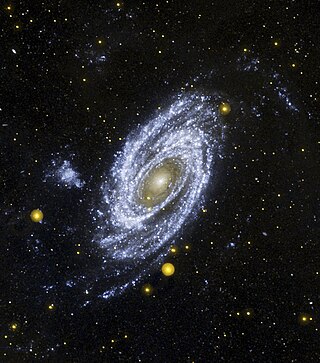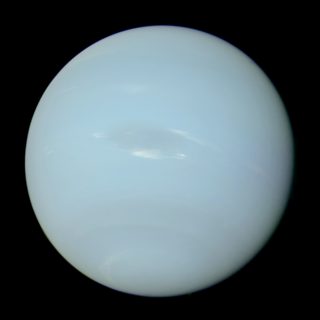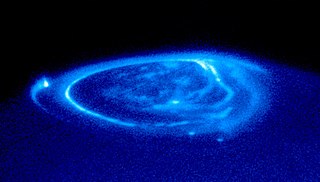
Jupiter is the fifth planet from the Sun and the largest in the Solar System. It is a gas giant with a mass more than two and a half times that of all the other planets in the Solar System combined, and slightly less than one one-thousandth the mass of the Sun. Jupiter orbits the Sun at a distance of 5.20 AU (778.5 Gm) with an orbital period of 11.86 years. Jupiter is the third brightest natural object in the Earth's night sky after the Moon and Venus, and it has been observed since prehistoric times. It was named after Jupiter, the chief deity of ancient Roman religion.

The Hubble Space Telescope is a space telescope that was launched into low Earth orbit in 1990 and remains in operation. It was not the first space telescope, but it is one of the largest and most versatile, renowned as a vital research tool and as a public relations boon for astronomy. The Hubble telescope is named after astronomer Edwin Hubble and is one of NASA's Great Observatories. The Space Telescope Science Institute (STScI) selects Hubble's targets and processes the resulting data, while the Goddard Space Flight Center (GSFC) controls the spacecraft.

Ultraviolet astronomy is the observation of electromagnetic radiation at ultraviolet wavelengths between approximately 10 and 320 nanometres; shorter wavelengths—higher energy photons—are studied by X-ray astronomy and gamma-ray astronomy. Ultraviolet light is not visible to the human eye. Most of the light at these wavelengths is absorbed by the Earth's atmosphere, so observations at these wavelengths must be performed from the upper atmosphere or from space.

Marc William Buie is an American astronomer and prolific discoverer of minor planets who works at the Southwest Research Institute in Boulder, Colorado in the Space Science Department. Formerly he worked at the Lowell Observatory in Flagstaff, Arizona, and was the Sentinel Space Telescope Mission Scientist for the B612 Foundation, which is dedicated to protecting Earth from asteroid impact events.

Sol Alan Stern is an American engineer, planetary scientist and space tourist. He is the principal investigator of the New Horizons mission to Pluto and the Chief Scientist at Moon Express.

Maria T. Zuber is an American geophysicist who is the vice president for research at the Massachusetts Institute of Technology, where she also holds the position of the E. A. Griswold Professor of Geophysics in the Department of Earth, Atmospheric and Planetary Sciences. Zuber has been involved in more than half a dozen NASA planetary missions aimed at mapping the Moon, Mars, Mercury, and several asteroids. She was the principal investigator for the Gravity Recovery and Interior Laboratory (GRAIL) Mission, which was managed by NASA's Jet Propulsion Laboratory.

Neptune has been directly explored by one space probe, Voyager 2, in 1989. As of 2024, there are no confirmed future missions to visit the Neptunian system, although a tentative Chinese mission has been planned for launch in 2024. NASA, ESA, and independent academic groups have proposed future scientific missions to visit Neptune. Some mission plans are still active, while others have been abandoned or put on hold.

Heidi B. Hammel is a planetary astronomer who has extensively studied Neptune and Uranus. She was part of the team imaging Neptune from Voyager 2 in 1989. She led the team using the Hubble Space Telescope to view Shoemaker-Levy 9's impact with Jupiter in 1994. She has used the Hubble Space Telescope and the Keck Telescope to study Uranus and Neptune, discovering new information about dark spots, planetary storms and Uranus' rings. In 2002, she was selected as an interdisciplinary scientist for the James Webb Space Telescope.

MAVEN is a NASA spacecraft orbiting Mars to study the loss of that planet's atmospheric gases to space, providing insight into the history of the planet's climate and water. The name is an acronym for "Mars Atmosphere and Volatile Evolution" while the word maven also denotes "a person who has special knowledge or experience; an expert". MAVEN was launched on an Atlas V rocket from Cape Canaveral Air Force Station, Florida, on 18 November 2013 UTC and went into orbit around Mars on 22 September 2014 UTC. The mission is the first by NASA to study the Mars atmosphere. The probe is analyzing the planet's upper atmosphere and ionosphere to examine how and at what rate the solar wind is stripping away volatile compounds.

Michele Karen Dougherty is a Professor of Space Physics at Imperial College London. She is leading unmanned exploratory missions to Saturn and Jupiter and is Principal Investigator for J-MAG – a magnetometer for the European Space Agency's Jupiter Icy Moons Explorer, due for launch in April 2023.

Reta F. Beebe is an American astronomer, author, and popularizer of astronomy. She is an expert on the planets Jupiter and Saturn, and the author of Jupiter: The Giant Planet. She is a professor emeritus in the Astronomy Department at New Mexico State University and 2010 winner of the NASA Exceptional Public Service medal.

Planetary science is the scientific study of planets, celestial bodies and planetary systems and the processes of their formation. It studies objects ranging in size from micrometeoroids to gas giants, aiming to determine their composition, dynamics, formation, interrelations and history. It is a strongly interdisciplinary field, which originally grew from astronomy and Earth science, and now incorporates many disciplines, including planetary geology, cosmochemistry, atmospheric science, physics, oceanography, hydrology, theoretical planetary science, glaciology, and exoplanetology. Allied disciplines include space physics, when concerned with the effects of the Sun on the bodies of the Solar System, and astrobiology.

Mark Robert Showalter is a senior research scientist at the SETI Institute. He is the discoverer of six moons and three planetary rings. He is the Principal Investigator of NASA's Planetary Data System Rings Node, a co-investigator on the Cassini–Huygens mission to Saturn, and works closely with the New Horizons mission to Pluto.

UVS, known as the Ultraviolet Spectrograph or Ultraviolet Imaging Spectrometer is the name of an instrument on the Juno orbiter for Jupiter. The instrument is an imaging spectrometer that observes the ultraviolet range of light wavelengths, which is shorter wavelengths than visible light but longer than X-rays. Specifically, it is focused on making remote observations of the aurora, detecting the emissions of gases such as hydrogen in the far-ultraviolet. UVS will observes light from as short a wavelength as 70 nm up to 200 nm, which is in the extreme and far ultraviolet range of light. The source of aurora emissions of Jupiter is one of the goals of the instrument. UVS is one of many instruments on Juno, but it is in particular designed to operate in conjunction with JADE, which observes high-energy particles. With both instruments operating together, both the UV emissions and high-energy particles at the same place and time can be synthesized. This supports the Goal of determining the source of the Jovian magnetic field. There has been a problem understanding the Jovian aurora, ever since Chandra determined X-rays were coming not from, as it was thought Io's orbit but from the polar regions. Every 45 minutes an X-ray hot-spot pulsates, corroborated by a similar previous detection in radio emissions by Galileo and Cassini spacecraft. One theory is that its related to the solar wind. The mystery is not that there are X-rays coming Jupiter, which has been known for decades, as detected by previous X-ray observatories, but rather why with the Chandra observation, that pulse was coming from the north polar region.

Amy Simon is an American planetary scientist at NASA's Goddard Space Flight Center, involved in several missions of the Solar System Exploration Program.

Emma J. Bunce is a British space physicist and Professor of Planetary Plasma Physics at the University of Leicester. She holds a Royal Society Wolfson Research Merit Award. Her research is on the magnetospheres of Saturn and Jupiter. She is principal investigator (PI) of the MIXS instrument on BepiColombo, was deputy lead on the Jupiter Icy Moons Explorer proposal, and co-investigator on the Cassini–Huygens mission.
Janet G. Luhmann is an American physicist and senior fellow of the Space Sciences Laboratory of the University of California, Berkeley. She has made major contributions to a wide range of topics in planetary, solar, magnetospheric, and heliospheric physics. She is the principal investigator of the IMPACT instrument suite on the twin-spacecraft STEREO mission. IMPACT stands for In-situ Measurements of Particles and Coronal mass ejection (CME) Transients. It consists of a, "suite of seven instruments that samples the 3-D distribution of solar wind plasma electrons, the characteristics of the solar energetic particle (SEP) ions and electrons, and the local vector magnetic field."

Kevin France is an astrophysicist and assistant professor in the Department of Astrophysical and Planetary Sciences at the University of Colorado. His research focuses on exoplanets and their host stars, protoplanetary disks, and the development of instrumentation for space-borne astronomy missions.

Kelly E. Fast is an American astronomer, program scientist, and science communicator who currently serves as the Program Manager for NASA’s Near-Earth Object Observations program, the Program Scientist for the NASA Infrared Telescope Facility (IRTF), and the Program Officer for NASA’s Yearly Opportunities for Research in Planetary Defense (YORPD) research solicitation. The portfolio Fast oversees is part of NASA’s Planetary Defense Coordination Office, which manages asteroid impact avoidance activities across NASA and coordinates U.S. interagency and international efforts to study and plan a response to the asteroid impact hazard. In 2003, main belt asteroid 115434 was renamed “Kellyfast” in honor of her contributions to planetary science.

















